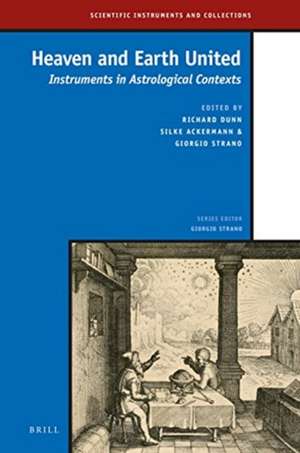Heaven and Earth United: Instruments in Astrological Contexts: Scientific Instruments and Collections, cartea 6
Richard Dunn, Silke Ackermann, Giorgio Stranoen Limba Engleză Hardback – 8 aug 2018
Contributors are Silke Ackermann, Marisa Addomine, Jim Bennett, Marvin Bolt, Louise E. Devoy, Richard Dunn, Seb Falk, Stephen Johnston, Richard L. Kremer, Günther Oestmann, Josefina Rodríguez-Arribas, Petra G. Schmidl, Giorgio Strano, and Sylvia Sumira.
Preț: 765.63 lei
Preț vechi: 1520.36 lei
-50% Nou
Puncte Express: 1148
Preț estimativ în valută:
146.52€ • 150.05$ • 121.88£
146.52€ • 150.05$ • 121.88£
Carte indisponibilă temporar
Doresc să fiu notificat când acest titlu va fi disponibil:
Se trimite...
Preluare comenzi: 021 569.72.76
Specificații
ISBN-13: 9789004362758
ISBN-10: 9004362754
Dimensiuni: 155 x 235 x 2 mm
Greutate: 0.58 kg
Editura: Brill
Colecția Brill
Seria Scientific Instruments and Collections
ISBN-10: 9004362754
Dimensiuni: 155 x 235 x 2 mm
Greutate: 0.58 kg
Editura: Brill
Colecția Brill
Seria Scientific Instruments and Collections
Cuprins
List ofFigures and Tables
Contributors
Introduction
1 Using Astrolabes for Astrological Purposes: The Earliest Evidence Revisited
Petra G. Schmidl
2 What’s on the Back of an Astrolabe? Astrolabes as Supports for Planetary Calculators
Seb Falk
3 Medical and Astrological Plates: Their Roles in Medieval and Renaissance Knowledge
Josefina Rodríguez-Arribas
4 “Preciseness and Pleasure”: The Astrological Diptychs of Thomas Hood
Stephen Johnston
5 Displaying Astrological Knowledge through Tabulation: Some Notes Pertaining to Particular Arrangement on Instruments
Günther Oestmann
6 Astrological Aspectaria on Early Modern Instruments
Louise E. Devoy
7 Italian Astronomical Clocks as Public Astrological Machines
Marisa Addomine
8 Astrological Time in Public Space: The Görlitz Arachne (1550) and Planetary Hours
Richard L. Kremer
9 The Heavens at the Medici Court: Antonio Santucci’s Cosmological Models
Giorgio Strano
10 Were Globes Used in the Practice of Early Modern Astrology?
Jim Bennett and Sylvia Sumira
11 Instruments and the Astrologer’s Image
Richard Dunn*
12 Defining Scientific Instruments in Astrological Practice: A Response
Marvin Bolt
Glossary 263
Richard Dunn
General Index 277
Contributors
Introduction
1 Using Astrolabes for Astrological Purposes: The Earliest Evidence Revisited
Petra G. Schmidl
2 What’s on the Back of an Astrolabe? Astrolabes as Supports for Planetary Calculators
Seb Falk
3 Medical and Astrological Plates: Their Roles in Medieval and Renaissance Knowledge
Josefina Rodríguez-Arribas
4 “Preciseness and Pleasure”: The Astrological Diptychs of Thomas Hood
Stephen Johnston
5 Displaying Astrological Knowledge through Tabulation: Some Notes Pertaining to Particular Arrangement on Instruments
Günther Oestmann
6 Astrological Aspectaria on Early Modern Instruments
Louise E. Devoy
7 Italian Astronomical Clocks as Public Astrological Machines
Marisa Addomine
8 Astrological Time in Public Space: The Görlitz Arachne (1550) and Planetary Hours
Richard L. Kremer
9 The Heavens at the Medici Court: Antonio Santucci’s Cosmological Models
Giorgio Strano
10 Were Globes Used in the Practice of Early Modern Astrology?
Jim Bennett and Sylvia Sumira
11 Instruments and the Astrologer’s Image
Richard Dunn*
12 Defining Scientific Instruments in Astrological Practice: A Response
Marvin Bolt
Glossary 263
Richard Dunn
General Index 277
Notă biografică
Richard Dunn is Senior Curator for the History of Science at Royal Museums Greenwich. His publications include The Telescope: A Short History (2009), Finding Longitude (2014, with Rebekah Higgitt) and Navigational Instruments (2016).
Silke Ackermann studied History, Languages and Cultures of the Orient, and History of Science at Frankfurt University (Germany). She worked for sixteen years in a variety of curatorial and managerial roles at the British Museum before taking up the Directorship of the Oxford University Museum of the History of Science following a two-year stint at a German University between these two roles. She served as President of the Scientific Instrument Commission of the International Union for the History and Philosophy of Science until 2017.
Giorgio Strano is Curator of the Collections at the Museo Galileo: Istituto e Museo di Storia della Scienza in Florence. He is involved in the study and popularization of the history of mathematical astronomy. He has published articles in Italian and international journals and has collaborated on the creation of exhibitions on the history of astronomy and science.
Silke Ackermann studied History, Languages and Cultures of the Orient, and History of Science at Frankfurt University (Germany). She worked for sixteen years in a variety of curatorial and managerial roles at the British Museum before taking up the Directorship of the Oxford University Museum of the History of Science following a two-year stint at a German University between these two roles. She served as President of the Scientific Instrument Commission of the International Union for the History and Philosophy of Science until 2017.
Giorgio Strano is Curator of the Collections at the Museo Galileo: Istituto e Museo di Storia della Scienza in Florence. He is involved in the study and popularization of the history of mathematical astronomy. He has published articles in Italian and international journals and has collaborated on the creation of exhibitions on the history of astronomy and science.








